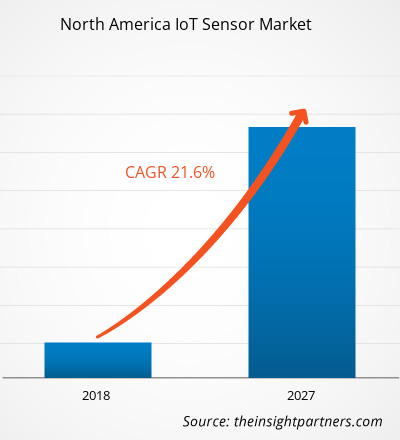IoT Sensor market in North America is expected to grow from US$ 3,609.9 Mn in 2017 to US$ 21,121.7 Mn by the year 2027. This represents a CAGR of 21.6% from the year 2019 to 2027.
Growing application of IoT and connected devices is fueling the North America IoT Sensor market. The advent of IoT has enabled each device to be connected over the internet and the rising adoptions would result in more than billions of devices connected over the internet. Also, validating to the above mentioned point is the fact that the data traffic rate on a global level, has grown at an annual rate of more than 65% over the last five years. Also, between 2018 and 2023, the data traffic is anticipated to grow at a compound annual growth rate of close to 40 percent. This exponential growth in data traffic over the internet is out rightly attributed to the growing penetration of smartphones and other consumer electronic devices that can be connected over the internet as a result of the growing popularity of IoT, thereby driving the IoT Sensor market in North America.
The mounting adoption of advanced technologies is anticipated to fuel the North America IoT Sensor market growth. The industrial sector is becoming increasingly entangled with Artificial Intelligence, big data as well as other such technologies. It is predicted that in the near future, automation will not only boost productivity but will also provide an advanced smart assistance to humans. The players are significantly investing in the development of industrial robots integrated with artificial intelligence. Further, the Chinese government is expanding its efforts to integrate artificial intelligence technologies into industrial sector. The integration of artificial intelligence will further reduce the intervention of humans, which will be beneficial for countries with inadequate and expensive labor force. These initiative by the market player are enhancing the growth of North America IoT Sensor market.
US is anticipated to leads the IoT Sensor market across the North America region through the forecast period. The US is a major global leader in industrial automation and associated equipment and controls. Industrial automation is broadly categorized into hardware and components which are used to automate systems in industrial or manufacturing settings. Most of the demand for IoT Sensors comes from the automobile and electronics manufacturing industries. This scope is facilitating the Applications to adopt this technology, thereby creating a substantial market for the same at present, which is projecting a positive growth on the IoT Sensors market. It will further propel the growth of manufacturing industry in the country thereby, accelerating the growth of IoT Sensor market in the U.S. This bolster the North America IoT Sensor market on the forecast period. The figure given below highlights the revenue share of Canada in the North America IoT Sensor market in the forecast period:
Canada IoT Sensor Market Revenue and Forecasts to 2027 (US$ Bn)
- This FREE sample will include data analysis, ranging from market trends to estimates and forecasts.
NORTH AMERICA AUTOMOTIVE SEMICONDUCTOR - MARKET SEGMENTATION
By Type
- Temperature sensor
- Light Sensor
- Pressure Sensor
- Chemical Sensor
- Motion Sensor
- Others
By Connectivity Type
- Wired
- Wireless
By Application
- Consumer Electronics
- Building Automation
- Healthcare
- Automotive
- Industrial
- Retail
- Others
By Country
- US
- Canada
- Mexico
Companies Mentioned
- Analog Devices, Inc.
- ARM Holdings PLC
- Broadcom, Inc.
- Honeywell International, Inc.
- Infineon Technologies AG
- NXP Semiconductors N.V.
- Omron Corporation
- Robert Bosch Gmbh
- STMicroelectronics N.V.
- Texas Instruments Incorporated
North America IoT Sensor Report Scope
| Report Attribute | Details |
|---|---|
| Market size in 2017 | US$ 3,609.9 Million |
| Market Size by 2027 | US$ 21,121.7 Million |
| Global CAGR (2019 - 2027) | 21.6% |
| Historical Data | 2015-2016 |
| Forecast period | 2018-2027 |
| Segments Covered |
By Type
|
| Regions and Countries Covered | North America
|
| Market leaders and key company profiles |
- Historical Analysis (2 Years), Base Year, Forecast (7 Years) with CAGR
- PEST and SWOT Analysis
- Market Size Value / Volume - Global, Regional, Country
- Industry and Competitive Landscape
- Excel Dataset


- Space Situational Awareness (SSA) Market
- Sleep Apnea Diagnostics Market
- Medical and Research Grade Collagen Market
- GNSS Chip Market
- Data Annotation Tools Market
- Lyophilization Services for Biopharmaceuticals Market
- Trade Promotion Management Software Market
- Sodium Bicarbonate Market
- Medical Audiometer Devices Market
- Online Recruitment Market

Report Coverage
Revenue forecast, Company Analysis, Industry landscape, Growth factors, and Trends

Segment Covered
This text is related
to segments covered.

Regional Scope
North America, Europe, Asia Pacific, Middle East & Africa, South & Central America

Country Scope
This text is related
to country scope.
Trends and growth analysis reports related to Electronics and Semiconductor : READ MORE..
The List of Companies
1. Analog Devices, Inc.
2. ARM Holdings PLC
3. Broadcom, Inc.
4. Honeywell International, Inc.
5. Infineon Technologies AG
6. NXP Semiconductors N.V.
7. Omron Corporation
8. Robert Bosch Gmbh
9. STMicroelectronics N.V.
10. Texas Instruments Incorporated

 Get Free Sample For
Get Free Sample For